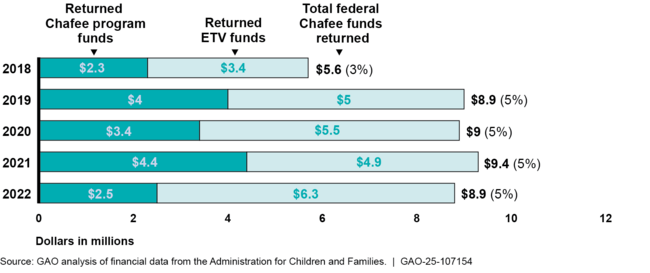Foster Care: HHS Should Help States Address Barriers to Using Federal Funds for Programs Serving Youth Transitioning to Adulthood
Fast Facts
The Department of Health and Human Services funds a program aimed at providing services for young people who are aging out of the foster care system. States have the flexibility to decide what services to offer, which can include things like housing and employment assistance.
For many years, states have returned millions of dollars to HHS—despite young people still needing these services. HHS officials plan to work with states to identify and address why funds were returned. But, HHS hasn't documented these plans. We recommended it do so to help ensure young people have access to the resources they need.

Highlights
What GAO Found
States generally have flexibility in determining the specific services offered to youth in the John H. Chafee Foster Care Program for Successful Transition to Adulthood. Selected state officials told GAO they decide on their service array by using data, participant feedback, and information from other states. Officials also reported offering youth services based on individual skills and needs. The most widely used services in selected states related to education, health, and housing.
The Department of Health and Human Services' (HHS) Administration for Children and Families (ACF) provides resources to help states select effective Chafee services. These resources include technical assistance, a database on services provided and youth outcomes, and evaluations of independent living programs. Officials in all six selected states told GAO they found ACF technical assistance helpful, but their use of the database and findings from evaluations varied. ACF officials said they have plans to increase the usefulness of both resources.
Officials in four selected states said state funds made up the majority of funding for Chafee services. Yet, states did not always spend all available federal funding, despite having unmet needs in serving youth. GAO's analysis showed that in fiscal year 2022, 12 of 51 states returned Chafee funds, and 28 states returned Chafee education voucher funds for a total of about $8.9 million.
Annual Total Federal Chafee Program Funds Returned by States, Fiscal Years 2018–2022

Note: Chafee Education and Training Voucher (ETV) grants support youth attending an institution of higher education. The number of states includes the District of Columbia. Numbers may not sum due to rounding.
ACF officials told GAO it is planning to send its regional offices information on which states return funds to facilitate conversations between regional staff and state officials on fully spending federal funds. ACF officials said they would begin this process soon but do not have a documented plan for this initiative, nor have they communicated this plan to regional offices. By documenting its plan and providing guidance to address barriers to spending, ACF can better ensure the Chafee program meets its objective to support youth as they transition from foster care to adulthood.
Why GAO Did This Study
The transition from adolescence to adulthood is a critical period and can be particularly difficult for youth aging out of foster care. Administered by ACF, the Chafee program supports youth in or formerly in foster care as they transition to adulthood.
GAO was asked to report on how states use Chafee program funds to assist older youth. This report addresses: (1) how selected states support youth transitioning from foster care to adulthood, (2) ACF resources for states on effective Chafee services, and (3) the extent that state and federal funds are used to support services for older youth.
GAO analyzed ACF expenditure data for fiscal years 2018 through 2022, the most recent available. GAO also reviewed federal Chafee allocations for fiscal year 2023. GAO also reviewed ACF's spending and program guidance for the Chafee program. In addition, GAO interviewed HHS officials and six state child welfare agencies selected for variation in federal Chafee funding, instances of returning unused funds, administrative structures (state vs. county), and geographic region.
Recommendations
GAO is making one recommendation to HHS, to document its plan to have regional offices work with states to address any barriers they face in spending federal Chafee funds and ensure the plan includes guidance on how regional office staff can help jurisdictions address these challenges. HHS agreed with this recommendation.
Recommendations for Executive Action
| Agency Affected | Recommendation | Status |
|---|---|---|
| Department of Health and Human Services | The Secretary for Health and Human Services should ensure the Administration for Children and Families documents a plan to have regional offices work with states, Tribes, and U.S. territories to address any barriers they face in spending federal Chafee funds and ensure the plan includes guidance on how regional office staff can help jurisdictions address these challenges. |
HHS agreed with this recommendation and said it would develop a plan to share information with regional offices on states, Tribes, and U.S. territories spending of Chafee funds. In addition, the agency said regional offices will use this information to reach out to relevant states, Tribes, and U.S. territories to discuss reasons for underspending and provide technical assistance. We will monitor the progress of these efforts.
|
